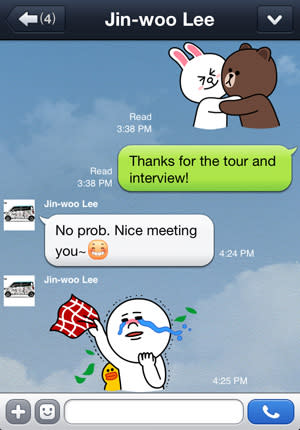The Growth Story and Future of Mobile Chat App Giant LINE

Mr. Kang Hyunbin, head of business office at Line Plus Corp
Popular mobile messaging chat app Line was created by NHN Japan, with Japanese and Korean team inspired by the tragic earthquake that happened in Japan in 2011. When SMS and calls were unreliable during the disaster, data messaging became the primary mode of communication.
As Line’s popularity grew, the app was spun-off in February this year into the Line Corp subsidiary. Besides facilitating chats between users, it has truly become a mobile platform incorporating different digital content including games and manga. Growing to 150 million users in less than two years hasn’t been easy. One of the reasons why Line has been able to grow so rapidly was because it has listened closely to its users’ needs. At NHN’s headquarters in Seoul, Korea, Kang Hyunbin, who is the head of business office at Line Plus Corp, told me:
I think users in Japan and the users in the world actually provide us the reason why we develop Line and what [way] to develop Line. Our users are kinda our co-founders.
Line characters and content

Hyunbin also believes that Line’s success hinges hugely on its rich content and user interface. For example Line users can express themselves with more than just words - there are the stickers that I would call an upgraded version of emoticons, and they have been hugely popular in Asia. Line has been extremely smart in developing different personalities for each of its sticker characters.

Starting with Cony, Brown, Moon, and James, these characters, who each represent different personalities, have been a huge hit in Asia. In Japan, Line’s kawaii characters are broadcast on TV in cartoon form and can also be found for sale as plush toys, T-shirts, and other merchandise. Take the pictured screenshot as an example. Expressing our sincere goodbyes to friends using stickers can be that fun.
Line also has games to entertain its users. One of its more popular games, Line Pop, is popular not just in Japan but also Thailand and Taiwan. So much so that it even has tutorial videos on tips and tricks to get more points.
Hyunbin told me that Line’s recently released manga content has been successful in Japan and the company has plans to bring it to other parts of the world.
Line outside of Japan
Line Japan focuses on the local Japanese market while the Korean headquarters focuses on international expansion. The ambitious chat application has been aggressively expanding to China, Vietnam, and Indonesia recently using both online and offline marketing tactics.
Chatting up China
Hyunbin says that Line’s China user base has grown rapidly despite early days. He explained further:
So far, we have established the basic infrastructure that we can do some more in the mainlaind China market. For example, Google Play doesn’t work in mainland China. So we have [to work with] a lot of third-party Android market. We have to modify our ‘apk’ files to suit into these third party markets […] and attract more users to download [Line].

Besides making adjustments to its Android distribution in China, Hyunbin says that Line’s cute stickers are getting many Chinese users on board. Line even introduced customized panda stickers to suit the local tastes and has also worked with local partners like Tmall and Mogujie to set up official accounts on Line.
Line’s plan in China is to target working women who are aged 20 to 30 in ‘tier one’ cities such as Beijing, Shanghai, and Guangzhou. Hyunbin explains that the characteristics of these users are very fashion sensitive. So it is only natural to work with Chinese e-commerce sites with fashion products such as Tmall and Mogujie. Hyunbin also said that Line hasn’t started to do any large scale promotion in China as the company is still trying to understand the market better such as the media structure and user requirements.
The user-base number isn’t big in China but we have a growth trend plus our own effort, which we are going to plan in the future. I have confidence that we do have more aggressive numbers coming soon that we can reach in the future.
Tencent’s WeChat - called Weixin in China - is the clear market leader there.
Thailand, Indonesia, Spain, and more
Unlike China, Line dominates Thailand with more than 15 million users from the country. In Thailand, Line noticed a familiar trend: Users simply love their stickers. “Again, the one big phenomenon in the Thai market is that users can express themselves really well using Line’s stickers,” said Hyunbin.
Line acknowledges that Thailand is a big market for them. In the future, it is looking to introduce Line branded merchandise in Thailand and also more localized content including Thai-language content such as news, manga, and celebrity accounts. Hyunbin is also open to work with local Thai-based game developers who are able to build games with a regional vision.
Besides China and Thailand, Line has been very active in Taiwan, Indonesia, Vietnam, The Philippines, and also the Spanish-speaking markets. Hyunbin explains that the popularity of Line in Spain has helped Line to organically grow in South American markets which mostly communicate in Spanish. In Spain, Line already has more than 12 million users.
Hyunbin highlighted that Indonesia is a key market for Line in Southeast Asia, stating the rapid growth in smartphone usage could signify that more people will be consuming mobile applications and content in the future. Based on Line’s internal data, it claims that it is the most popular chat application by user count.
The company declined to reveal user numbers for country-specific breakdowns, but said that out of 150 million users, 45 million of them are from Japan. So 70 percent of Line’s users are outside of Japan.

“We have no time to be worried about IPO.”
As Line grows into a giant mobile platform, there is more and more content on the mobile chat application. Hyunbin acknowledges that there could be a case where Line users (just like Facebook is experiencing now) may find the service complicated and overloaded with content. The team is careful with that and is constantly trying to simplify its features. On content selection, Line picks content to suit the local market, ensuring that they are relevant for its users. Hyunbin gave me a case in point:
For example in e-commerce there are global big players. But in each market, there are also local key players. In some ways, we [would like] to partner with the local companies to bring the best experience to users in specific markets.
When I asked when Line will go public, Hyunbin says that the company has no plans for that, saying that users are still their top priority. Jin-woo Lee, head of Line’s Southeast Asia team added:
A lot of people think that Line is quite big already. But if you take a look at the growth rate, in a year or two, we can be two or three times bigger than now. It all depends on expansion first. We need to create a bigger user-base then everything will be quite natural for an IPO. We have no time to be worried about IPO.
In Line’s first quarterly financial results that came out last week, the subsidiary revealed that it recorded $58 million in revenue in Q4.
The post The Growth Story and Future of Mobile Chat App Giant LINE appeared first on Tech in Asia.



